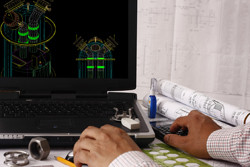Modelling nonlinearities and coupling
Industrial manufacturers of large-scale structural components utilise simulation programs for design optimisation. Currently available software packages primarily optimise linear static and modal finite element-modelled structures. Computer-aided engineering analysis software is typically specific to a single phenomenon. There is an urgent need to include nonlinear and multiphysics effects in which closely coupled interactions occur among separate phenomena. EU-funded scientists are addressing the challenge with work on the project 'Large scale industrial structural optimisation for advanced applications' (LASCISO)(opens in new window). Within the first reporting period, the team made excellent progress toward their goals. They developed a multiphysics topology optimisation prototype implemented in Matlab that promises a significant reduction in computation time. A similar topology optimisation algorithm was established for highly nonlinear elastic problems. Sensitivity analysis is an important component of structural simulations as it supports designers in determining the sources and effects of uncertainty to build more robust models. LASCISO is in fact extending current sensitivity-based models and so researchers developed several sensitivity analyses for topology and geometric nonlinear shape optimisation. Simulating a surface from predefined nodes or point clouds, sets of data points in a coordinate system, is critical to structural modelling. The ideal is to use the minimal data set and computations with the maximum accuracy. The team has also established both classical and rapid surfacing methods to transform point clouds into highly efficient models. Finally, in order to test performance of the technology, investigators developed systematic experiments evaluating the effects of a number of algorithm parameters and implemented them on products of interest. Many of the algorithms have already been applied in an industrial setting. LASCISO scientists intend to provide European engineers with structural optimisation software that will give them an edge on the competition. Capability to handle nonlinearities and multiple interacting phenomena should help developers deliver higher-performing products that are also better for the environment.







